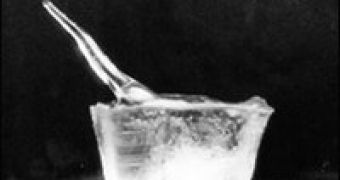Have you ever seen an ice cube with a strangely looking spike coming from it? How can a flat surface of water freeze upwards, defying gravity to form this unusual thorn?
It's just physics.
Water is a substance more complex than you might have thought. Besides being the absolutely necessary element for life in this world (which is a formidable property on its own), it also exhibits some unusual properties.
It can be used as a solvent and cleaning agent for most substances, being referred to as "the universal solvent", it can mix with many liquids (except oils) and it can exist in all three states, liquid, gaseous and solid, in the same time, at what is known as "the triple point". At the exact temperature of 0.01 degrees Celsius (273.16 Kelvins) and the pressure of 611.73 Pascals (0.0060373 atmospheres), ice, liquid water and water vapor coexist in a stable equilibrium.
It is precisely one of these interesting properties that accounts for its weird behavior during freezing, where the gravity-defying thorns appear.
While most substances contract themselves when freezing (shrinking by decreasing their volume), water does exactly the opposite and expands. That is why a glass bottle of water in a freezer may actually break if not thick enough to withstand the pressure generated by the increasing volume of water.
When a thin crust of ice forms, it can trap a tiny bubble of liquid below. As the freezing goes deeper, the water tries to expand until it reaches a tiny hole in the lower layer of the ice crust.
The bubble tries to go up, but the road is blocked by the hole, so as it begins to solidify, it is forced up through the hole and starts freezing around the edges. Step by step, the droplet shrinks by freezing and the only way the remaining liquid can go is up.
As it climbs, it forms a hollow spike filled with water, until it freezes completely. The spike can grow quite long and thin, as the only energy required to lift the water comes from the expansion of the water itself, during the freezing process.
It seems that the best environmental conditions include an air temperature of about -7 degrees Celsius (20 degrees Fahrenheit), which allows for a rapid freezing that favors the forming of tiny crystals that direct the freezing.

 14 DAY TRIAL //
14 DAY TRIAL //